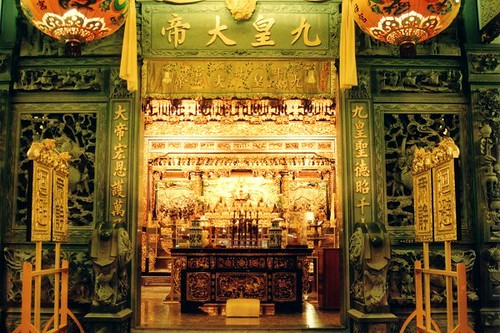Guests: Shua Hu, Gonkia, YY, Ah Leng (Dragon), Penangkia (silently) & Ong Boh Nio Nio
Today YY came into the recoridng with a lot of his personal experience in regards to Kiu Ong Ia. I learned a bunch from chatting with them. In the middle of the chat, a few laughs are unavoidable. Enjoy and have a holy Kiu Ong Ia, if you do celebrate! Or happy eating, if you just love vegetarian food like me. Share your own Kiu Ong Ia stories in our Penang Hokkien forum.
Kuan Kong and Ah Tox and a few more listeners started their own podcast called:
PenangHokienTV2.podomatic.com
=== Take part in our Penang Hokkien Forum and be involved in the show. And add yourself to Penang Hokkien Frappr Map. Just click on the banner on the top right corner. ===
NOTE:The best way to listen to the show is to subscribe to it. iTunes is one of the simplest ones to use. After downloading iTunes and installing it. Just come back to this page and click on the “Subscribe PenangHokkien via iTunes” button on the left. When the Penang Hokkien page comes up in iTunes. Simply click “SUBSCRIBE”. Once you are subscribed. You will never miss another episode. And you’ll be the first ones to get a brand-new show.







sia soi lo wa… sorry bo hong pian kong during recording.
Actually the 9th of Sept of Chinese Calender for Kiu Ong Ia actually is to remain that the 9 pirates death. If you got visit any of praying ceremony,you will see the situation is like giving last respect ( like someone die, we will do the saikong things).or know as “cuo-ki” and yet, all the foods selling around this ceremony MUST BE vegeterian. or else when “khi tang” the person khi tang ,either will khi siao (eh this is because he din prepare himself eat vegeterian on early time), or when khi tang Kiu Ong Ia come, the stall will be demolished by Kiu Ong Ia, it did happenned at here, Bkt Mertajam site before.
Oh ya, forgot to say,once when the last day,they sent the ship to the sea, the “lorzhu” or know as the person incharge after sent the ship he must quickly take 1 object from sea bed (anything) and then wrap it with yellow fabric,very fast,unable to see what is that object,it representing the head of Kiu Ong Ia.
I would like to add somemore regarding preparations of welcoming the Kiu Ong Ia.There is a ceremony called the Tall Lamp (Ko Teng) Raising Ceremony.
This ceremony is performed in the evening of he last day of the eighth moon. A post made from a whole tree trunk is first erected.Nowdadys they even made the post from big round metal. The Tall Lamp, hung on a bamboo pole together with its leaves, twigs and branches, is raised by a pulley and fastened to the top of the post.
The Tall Lamp or the Ko Teng consists of nine wicks-in-oil in a glass cover. They are arranged in three rows : two wicks at the top row, three at the second and four at the bottom.
This Tall Lamp represents Kiu Ong Ia. Once the Tall Lamp is lighted and raised, it signifies the arrival of Kiu Onh Ia to preside over the Festival and thus the Vegetarian Festival begins. The Tall Lamp is lowered by a pulley to add oil to the wicks and raised to the top of the post every day in order to prevent the light from going out. According to devotees, their lives depend on the Tall Lamp and they believe that if any of the nine wicks-in-oil go out, something disastrous will happen to them and to the whole community.
This Tall Lamp is lowered on the tenth day of the ninth moon after Kiu Ong Iah
goes back to Heaven at midnight of the ninth day. After the Tall Lamp is lowered and put away, the Vegetarian Festival has ended
So i add on somemore the event on the night at the temple before all the devotes departing to the seashore.It started with loud drums and gongs beat while priest texts were read and he asked TaoBo Neo for permission to bring her statue “Kim Sin” to the sedan chairs. After the permission granted it is followed by the golden urn”Kameyan Loh”of hers following with Kiu Ong Ia golden outfit and Sword,and lastly his stamp(Ong Ia cop)The 1 carry the Tau Bo Neo Kim Sin must kneel down and bring to the Sedan Chair..All the devotees will kneel down and kow tow when the sacred statue were caried out.
Then the sedan chair is loaded on a lorry to the seashore.The distances from the seashore to the temple is around ~10km.All the devotes will be waiting there until the welcoming ceremony starts
YY… i nto want to pai the 9 Long Ya… i wan to Pai u also.. u very geng…!!!!!…
wo.. eh.. Holand got 9 Long Ya…. u can celebrate thr.. kaka.. ifdun have u start…:P
Wakaka.Gonkia,i just share my experienced for this past few years after really having the vehetarian diet and the the festival itself.I think there is not even much temple in Holland.I also celebrate here as i’ll start vegetarian diet this Friday for 11days..
Here u can’t Luan Luan Lai,later i get to eat FREE bread lo….
hahaha
gongkia siao siao one…. hahahhahaha
maybe he cor siao…. or maybe too innocent liao….
hahahaha YY can i pai u also???
YY haa… pai seh pai seh…:P hee… not la.. you really very experince lee… cool cool….
Um have to learn more from you loo heee..:D
Haa.. i really Luan Luan lai one leee… Previously I in penang… i also vegetarian but after come to Kl. wooo in cyberjaya….. hard to get Vegetarian Food to eat looo…:P
Eh, YY u can set-up a http://www.Kao-Ong-Ya.com provide… the ppl not in malaysia also can celebrate in oversea. kaka…
Kuan Kong:- we can set a YY Temple kakaa..:P
Eh who knw? Kao Ong Ya… its celebrate also in Others country or only in Malaysia.
I asked my fren in Kwang Chow said there no ppl celebrate woo…
😀 hee who knw?
kuan kong,lu mai pai wa la….Wa boi cho sian…..
Not so experienced la..Just because this few years joining Kiu Ong Ia so nothing a few things nia.I will share a few more things with you all later..
Haha…Good arr a webpage for all ppl around the world…Not so expert in those web paging things….
Kiu Ong Ia not only celebrated in Malaysia nia.Thailand at Phuket,Singapore and China..
That’s why Kiu Ong Ia have so many version of story….
Later i will post to you all the story that i think i heard and and know from website that i believe to the original story of Kiu Ong Ia
I really learned a lot from the guests. I had no idea.
This are some IMPORTANT rulesespecially on Kiu Ong Ia Jit
10 RULES FOR THE VEGETARIAN FESTIVAL
1. Cleanliness of bodies during the festival
2. Clean kitchen utensils and to use them seperately from other who do not join the festival
3. Wear white during the festival
4. Behave physically and mentally
5. No meat eating
6. No sex
7. No alcoholic drinks
8. People at mourning period should not attend the festival
9. Pragnant ladies should not watch any ritual
10. Ladies with period should not attend the ritual
Haloo Tei Keh Ho Boo.
Ok as i promise to all,this is the story of Kiu Ong Ia that is in Toaism..
The Nine Emperor Gods are referred to by devotees as Kiu Ong Iah. They are also called Kiu Ong Tai Te, which means the Nine Great Emperors.The Nine Emperor Gods are star deities. They are the seven stars of the Big Dipper. The other two gods dwell in two other stars nearby which are visible only to the eyes of immortals.
In the past, the Big Dipper was associated with the Chinese life. These stars were believed to have control over the face of human beings. According to ancient Chinese beliefs, the Big Dipper was supposed to decide the fate of individuals as well as the welfare of the state. The Nine Emperor Gods, therefore, are believed to have control over people�s fate.
The mother of the Nine Emperor Gods was called Doumu, or Taobo in Hokkien dialect. Doumu was said to have been born in India. She later came to China and was married to a Chinese king by whom she had nine sons who were later deified and were known as Kiu Ong Iah. Doumu or Taobo herself was deified as the Goddess of the North Star. Having a deep compassion for the suffering of mankind, Doumu is the Taoist counterpart of Kuan Yin. The Chinese female form of the Buddhist Bodhisattva Avalokiteshvara.
Like the ancient Greeks, the Chinese were star worshippers. During the Han dysnasty (202 B.C.-A.D. 220), star worship was firmly established in China. Therefore, the Nine Emperor Gods could have become star deities before Taoism developed in China in the Second century A.D.
When Buddhism entered China, the Chinese accepted the religion easily ass Buddhist precepts call for benevolence and abstinence from killing. The Nine Emperor Gods then became the Bodhisattvas manifesting themselves in the form of the planets in our solar system and they are also believed to have control over the destiny of human beings.
So listed below are the name of the star for each of the son.
Star name Esoteric Name Western Star Trigram Elements
1. Tian Feng / ? ? Tzu Chin Vega Kan Water
2. Tian Ping / ?? Tzu Hsu Alkaid Kun Earth
3. Tian Chung Tzu Chiao Mizar / Alcor Chen Wood
4. Tian Fu Tzu Hsiang Alioth Sun Wood
5. Tian Chin Tzu Chin Megrez Earth
6. Tian Hsin Tzu Hsiang Phecda Chien Metal
7. Tian Chu Tzu Chung Merak Tui Metal
8. Tian Jen Tzu Chang Dubhe Ken Earth
9. Tian Ying Tzu Cheng Polaris / North Star Li Fire
For the star layout i will post it in the Kiu Ong Ia Forum.You al can chek it there
During this ‘Kao Wong Yeh’ festival,many devotees will also go on a pilgrimage to the ‘Cheng Kuan Soo’ also known as the ‘Cheng Jee Can’ (One Thousand Two Hundred Steps Temple).The temple is situated on a hill at Paya Terubong,Penang.It is believed that anyone who wants to visit the temple must go on a strict vegetarian diet. There are stories of those who challenged this belief being punished severely by the gods.The place is considered very holy as it houses many ‘Tua Sin’ (Great Spirits) like the ‘Kau Wong Yeh’, ‘Tao Boh Niao’, ‘Thai Siong Lao Kun’, ‘Ma Chor Poh’ and ‘Kuan Im Phor Sat’.
Pilgrims will have to climb the granite steps to reach the temple.Those who can’t can opt to drive up.It will take a 45 minute hike to reach to temple.The temple is known to be very ‘siah’ (powerful, can grant wishes).
When I went up there, I saw a boy, about 7-8 years old in a trance like manner. He sat cross legged on the floor, in front of the shrine. He looked like he was in deep meditation. Is he communicating to the great beings there?I don’t know.May be he would be an instrument to the gods later in life to help others. (in other words, he is called to be a ‘tang ki’).
On my way down, I saw a man carrying a bog of rice (10 kg) up on his head hiking up the temple.It looks like he has a prayer granted.
Well, whatever it is, I thank heaven that I’m able to make a successful pilgrimage up there and see those wonderful moments. I pray for a harmonious world. may world peace prevail.
Hello haven’t been here in a while. This recording is very funny as we laugh at others mistake and also dogs bark while people pronounced ??? as ???
I noted Ah John explanation for Kiu / Kao Ong Ia. I wish to explain the pronunciation of Hokkien numerals in more detail:
Generally all hokkien numerals have two pronunciation, one is called literal pronunciation ??, the other one is colloquil pronunciation ??. For example
1 = yit1(literal), jit1(colloquial),
2 = ji3(literal), nor3(colloquial),
3 = sam1(literal), sna1(colloquial)
4 = su(literal), si3(colloquial)
…
9 = kiu(literal), kao4(colloquial)
Traditionally all formal terms are pronounced in literal pronunciation, for example ?? sam3poh4, not sna3poh4. Also ??? is kiu1ong1ia2, not kao1ong3ia2. However as our Hokkien and Chinese culture get diluted, many formal terms are not pronounced, and many people forget the literal pronunciation of numerals other than 1 & 2. In Amoy Hokkien years are pronoucned all in literal pronunciation 1932 (yit kiu sam ji ni) but in Penang Hokkien and also Teochew it is pronoucned in colloquial pronunciation except for 1 & 2: (yit kao sna ji ni). I think Penang might have preserved more traditional pronunciation hence literal pronunciations since there were many Chinese schools in Penang island (more so in Singapore) teaching using Hokkien as medium of instruction before 1920. Hokkien elsewhere like Kedah gets degraded more quickly since Hokkien population there is more diluted.
So I think Kiu1Ong3Ia2 is the original form or should I say more formal form used, rather than being modified by Penang people from Kao1Ong3Ia2 because it sounds exactly like dog in Hokkien.
Also I think ?? should be tai3 tae3, since it is a very formal term and literal pronunciations are usually used for formal terms.
[Wikipedia – Penang Hokkien]
Literary and colloquial pronunciations
Hokkien has not been taught in schools in Penang since the establishment of the Republic of China in 1911, when Mandarin was made the Chinese national language. As such, few if any people have received any formal instruction in the language, and it is not used for literary purposes. However, as in other variants of Minnan, most words have both literary and colloquial pronunciations, and the literary pronunciations still appear in limited circumstances, e.g.:
* in given names (but generally not surnames), e.g. ? an1 rather than oa?1, ? giok8 rather than gek8
* in a few surnames, e.g. ? iap8 rather than hioh8
* in other proper names, e.g. ??? Liong5-san1-tong5 rather than Leng5-soa?1-tong5
* in certain set phrases, e.g. ??? chha1-put4-to1 rather than chh?1-m7-to1, ?? kien3-siau3 rather than ki?3-chhio3
Unlike in Taiwan and mainland China, the literary pronunciations of numbers higher than two are not used when giving telephone numbers, etc. Literary variants are generally eschewed in favour of colloquial pronunciations, e.g. ?? toa7-oh8 instead of tai7-hak8.
2 = nor, ji
Thank you for your detailed explanation.
I remember also, when we play mahjong, we call 1 and 9 ans “iou kiu” and not “iou kao”
Hi Ah John,
If you do a contrast between colloquail Hokkien (cHok), literal Hokkien (lHok), Hakka (Hakk) and Cantonese (Cant) pronunciation of 1 to 10 you will see how interrelated the dialects are:
cHok lHok Hakk Cant
1 jit yit yit yat
2 no ji ngi yi
3 sna sam sam sam
4 si su si sei
5 go ngo ng ng
6 lak liok luek lok
7 tshit tshat tshit tshat
8 paek pat pat pat
9 kao kiu kiu kao
10 tsap sip sip sap
As you can see Hakka and literal Hokkien are pretty close. This is because literal Hokkien was formed around the time Hakka settlements occur in Southern China. Evidence of common ancestry of Hakka and Hokkien (at least part of it since people settled in Hokkien before that era. Colloquial Hokkien forms before Hakka settlements were formed, possibly with common ancestry of Fuzhao. Even further before that connections can be made with Shanghainese. Hokkien and Cantonese are close too (look at number 6, 7, 8, 9, 10) as they are the two dialects that first started to form in southern China. Also look at very fundamental word like ‘eat’: jiak in Hokkien, yak in old Cantonese (as in yak3si2 = eat shit) which has been largely been replaced by ‘saek’ (closer to Hakka ‘sit’).
Sorry for my longwinded explanation as Chinese dialects are so fascinating that I can’t stop when start talking about them.
>>In Amoy Hokkien years are pronoucned all in literal pronunciation 1932 (yit kiu sam ji ni) but in Penang Hokkien and also Teochew it is pronoucned in colloquial pronunciation except for 1 & 2: (yit kao sna ji ni).
Sorry I should have noted that the later (yit kiu sam ji ni) pronunciation is used in: Teochew in China & overseas, Hokkien people outside China including Penang and Singapore (not sure about Taiwan)
I had the opportunity to be in Butterworth Nine Emperors festivals and wrote a little what I know. you can find it here.
in wordpress:
https://penangisland.wordpress.com/2007/10/21/nine-emperor-gods-festival/
in my own site: for Butterworth:
https://www.my-island-penang.com/nine-emperor-gods.html
https://www.my-island-penang.com/9-emperors-gods.html
for kepala Batas:
https://www.my-island-penang.com/9-emperor-gods.html
and I will be writing for Cheng Jee Chan tommorrow
great forum ..god bless Keep up the good work.
Pearl
Pearl,
Thanks so much for the links. I’m reading them now.
Hi John,
I should thank you for reading and i uploaded two more page today.
https://www.my-island-penang.com/Spirit-Mediums.html together with a video of the spirit mediums playing the hot oil. Truly incredible and amazing
Wrote about Cheng Jee Chan too as I love this 130 old year very much.
https://www.my-island-penang.com/Cheng-Kon-Sze.html
Have fun and I am glad to write.
Cheers and god bless all
‘d like to know more about the originor history of the nine emperor gods.
And how and where can I learn the true teaching of nine emperor gods .
Thank you.
hai every one how are you today
hello everyone
????????????????????????????????????????? everyone not me again :3